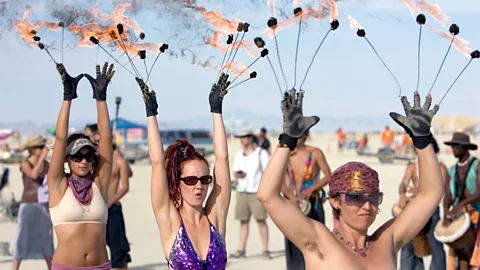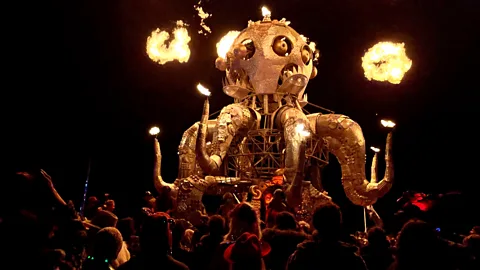Burning Man: Why the US festival could be in trouble
 Getty Images
Getty ImagesAs news of rising prices, intolerable weather and poor ticket sales have hit the Nevada desert event in recent years, some speculate its days could be numbered.
This weekend, tens of thousands of people will head deep into the Nevada desert to Black Rock City, a temporary metropolis that rises out of the dust every year to play host to Burning Man. For 10 days attendees - or rather, "Burners" - come together on the playa, a vast expanse of flat, inhospitable land. There are large scale art installations, mutant cars, performances, DJ sets and all manner of weird and wonderful events, from self-help talks to sex parties. Don't call it a festival though. No money changes hands at Burning Man (instead, it's about self-reliance and gifting), and the closest thing there is to a headline act is the event's climax, the burning of a large wooden effigy, the "Man" himself.
If any of that sounds appealing, then you're in luck because, for the first time in over a decade, Burning Man has failed to sell out (in previous years tickets have all been snapped up months in advance), prompting speculation that the event has lost its spark. The slow sales are the latest blow in what's been a rocky few years for Burning Man. The event was cancelled for two years during Covid (though an unofficial "renegade burn" still drew 20,000 people to the desert in 2021). When it returned in 2022 the weather was scorching, with temperatures reaching an intolerable 100F (38C) and dramatic dust storms.
Last year, torrential rain turned the site into a mud bath. Roads in and out of the festival were shut off and organisers told attendees to "conserve food and water, shelter in a warm space". Some hiked for miles to get out. Diplo (who had performed a DJ set in a hot air balloon) hitchhiked out with comedian Chris Rock. There were (false) rumours of an Ebola outbreak. Meanwhile, on the internet, many seemed to revel in what was happening – with endless memes making fun of those stranded at the event and likening it to the doomed Fyre Festival. The schadenfreude was likely due to Burning Man's increasing reputation as a hangout for wealthy "tech bros", including Mark Zuckerberg and Elon Musk (who called it "unique to the world"). In recent years celebrities and influencers have flocked to the event.
 Getty Images
Getty ImagesCritics of Burning Man say that the event has strayed too far from its countercultural roots, that it's too big, that – despite its "leave no trace" policy – it's causing environmental damage (last year, climate activists blocked the route in). Together, all this has led to suggestions that Burning Man is experiencing something of an existential crisis. And yet, even if the numbers are down on last year, there are still hordes of people more than happy to head into the desert for the experience. "Nothing really comes close to the whole package of what is essentially a survivalist desert camping trip pretending to be an epic arts festival," says Adriana Roberts, who has been to Burning Man 30 times.
Early roots and rituals
Burning Man's roots go back to 1986, when two friends from San Francisco, Larry Harvey and Jerry James, dragged an 8ft (2.4m) sculpture onto the city's Baker Beach and set fire to it to celebrate the summer solstice, with around 35 people gathered to watch. The burning of a giant figure become an annual ritual, with both the sculpture and the crowd growing each year. In 1988, 200 people were there. By 1990, the police had stepped in to say the event couldn't take place on the beach, and the event moved to the Black Rock desert in Nevada – with members of San Francisco art collective the Cacophony Society now involved with the event.
Roberts, a DJ who for decades published an independent newspaper at Burning Man, first went in 1993. "It wasn't this whole epic thing then," she tells the BBC. "It was literally just going to the desert to camp with some friends for the weekend, with some kooky art shit happening. It was a lot of artists and pranksters and kind of this anarchic vibe." There were about 800 people that year, mostly from the San Francisco area. By the next summer, attendance has doubled – and The New York Times was writing about the "irreverent arts festival and impromptu community". In those early years, that community assembled itself in a pretty haphazard way. "It was just people randomly in the desert organising it, very guerrilla style," says Roberts.
But with attendance roughly doubling every year, that chaos tipped over into tragedy in 1996 when a man died in a motorcycle accident leading up to the event and, in a separate incident, three young people were seriously injured when a car ran over their tent.
Organisers clashed over the event's future. Larry Harvey thought anarchy needed to be replaced with order. Co-founder John Law believed structure would change the whole spirit of the event, so left. Harvey envisioned Burning Man as a city, even working with an architect to design the now famous semi-circle layout. "Larry Harvey was like, 'we need to get this under control'," says Roberts. "You know, what cities have? Cities have rules. Cities have civic structure. Cities have streets."
From the start Burning Man existed as a rejection of materialism and commerce, and a celebration of self-expression, communal living and collective responsibility – but in 2004 Harvey solidified those ideals into Burning Man's 10 Guiding Principles, which include radical inclusion, decommodification (no logos are allowed), gifting and leaving no trace.
Imposing "rules" didn't go down well with everyone, especially some old-time burners. "Some people are more anarchistic," says sociologist Katherine Chen, the author of Enabling Creative Chaos: the Organisation Behind the Burning Man Event. "They didn't like the idea of an organisation saying, here are some guidelines for behaviours. They truly thought they could do whatever they want. But the problem is, if everyone just did what they wanted, some people would do fairly reasonable things but others would not."
Integrating with the community is an important part of the Burning Man experience. "Quite a lot of burners twitch at the term 'festival'," says Katherine Blackler, a personal organiser from London who went to her first Burning Man in 2015 and will be attending her seventh this year. "Yes you pay for a ticket, but the idea is very much around participation rather than expecting to be entertained," she says.
"Burning Man catches a lot of people's attention for being a hedonistic drug-fueled orgy in the desert. And yes, there's a lot more liberalism out there and opportunities to party, but there's so much more to it. I'm teetotal now and I've done five years there without alcohol and there's so much still available to challenge and stimulate you. The art and the creativity blows my mind every time." But Blackler says, more than anything, it's the people she's met there that make it special. "I made such intense connections at my first burn, and it's those friendships that keep bringing me back," she says.
 Getty Images
Getty ImagesIn 2011, Burning Man sold out for the first time and – until this year – has done every year since. That year, attendance had reached nearly 55,000, and it would continue to grow, reaching 80,000 in 2022. As the event attracted more people – and attention – some started to question its direction. "If you go back and look at the news media, every year people are like, 'Burning Man is over'," says Chen. "People were even saying that early on. But if you're developing a city or community, change is inevitable."
But as stories emerged of people paying $100,000 (£76,000) to stay in luxury camps, attendees flying in on private jets and influencers doing sponsored photoshoots on the playa, Burning Man seemed to become fair game for people to hate on. Even organisers admitted they were disheartened by the "commodification and exploitation of Black Rock City and Burning Man culture".
Why people are 'burned out'
There's a common narrative that the Silicon Valley crowd descended and ruined Burning Man – but the two have long had a close connection. "By 1995 the tech people had discovered it," says Roberts. Wired magazine put the event on its cover in 1996, calling it "the new American holiday". A 1999 report from Burning Man in Forbes reported that: "Jeffrey Bezos of amazon.com is here." Google's co-founders famously found their CEO at Burning Man. Neil Shister, author of Radical Ritual: How Burning Man Changed the World, wrote in a 2019 Washington Post piece: "inspiration from Burning Man's humanism propelled the early days of Silicon Valley and helped engineers frame their work as making the world a better, more open, place".
In a world where tech companies now wield such immense power, that early idealism seems almost quaint. Professor Fred Turner of Stanford University, who has studied the relationship between Silicon Valley and Burning Man, argues that: "the tech industry and Burning Man have followed parallel trajectories in that both have become suffused with so much money that the countercultural impulses that drove some of their founders have become much harder to see".
Though it preaches "radical inclusion," Burning Man has never been especially diverse (Larry Harvey once tried to justify this by saying: "I don't think black folks like to camp as much as white folks"). Things are slowly improving, but according to the 2023 Burning Man Census people of colour still only made up 14.5% of attendees.
As the cost to attend has gone up, attendees have become more affluent. The census shows that in 2023, 61% of those attending came from households with income over $100,000 (and 17.5% from ones earning over $300,000).
 Getty Images
Getty ImagesAn increasingly wealthy crowd is just one of several reasons why last year's Burning Man, her 30th, was Roberts's last. "Burning Man in a lot of ways is a microcosm of American culture. There's this idea of keeping up with the Joneses." Despite being a hardcore burner herself, she also thinks the guiding principles can make Burning Man feel a bit like a cult. "There can be this 'burnier than thou' attitude within the community, where it's like, 'oh, well, how many times have you been? Are you doing it right?'" She says as the festival has grown, she's also struggled to connect with people in the same way that she used to.
Then there's the weather. "I can't deny it. I've been going for 30 years, and my last two years were brutal," she says. "Two years ago I got heatstroke. I can handle a little mud, rain or heat. I come prepared. But it beat me down. Turns out the Black Rock Desert is a really stupid place to have a party!" A lot of old-timers she knows feel the same, and are ducking out this year.
In 2023, 43% of attendees were "virgin" burners – up 15% on the year before. "Quite frankly, this is not a bad thing," says Roberts. "Burning Man needs these kind of things to happen to get new blood, new ideas, to shake shit up. There should be some turnover. It's healthy."
Despite being burned-out herself, Roberts says she will always love Black Rock City. Is she worried about its future? "It's going to survive. It might not be 80,000 people every single year, but there will always be people that want to discover Burning Man for the first time."
--
If you liked this story, sign up for The Essential List newsletter – a handpicked selection of features, videos and can't-miss news, delivered to your inbox twice a week.
